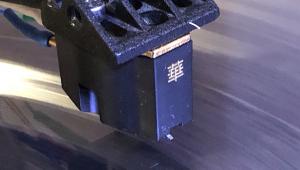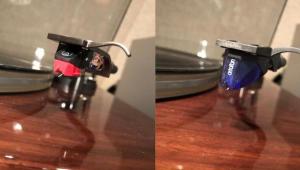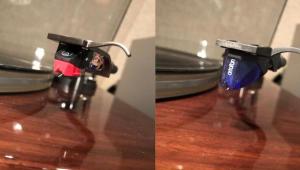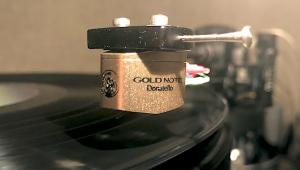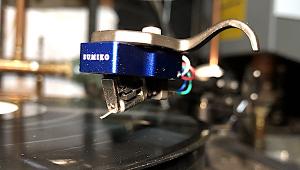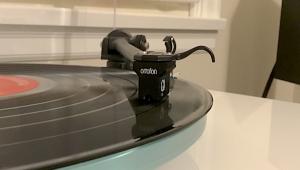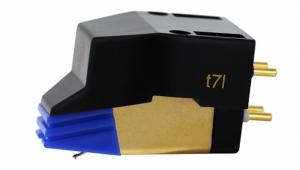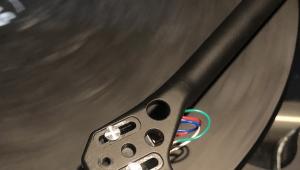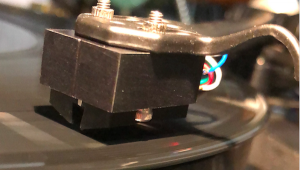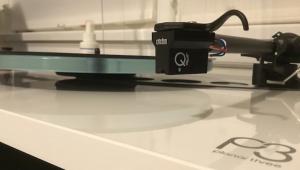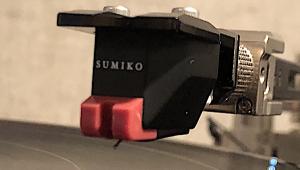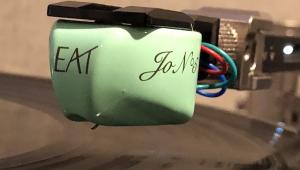Allaerts MC2 Finish Gold phono cartridge
Likewise, I haven't been able to procure a Schröder tonearm or an Allaerts cartridge. Both Frank Schröder and Jan Allaerts have waiting lists for their hand-built products, so they hardly need publicity—but I need to hear their products.
Unsolicited and out of the blue, a reader in Mexico recently offered me the use of his Allaerts MC2 Finish Gold cartridge ($6500). Handling a review sample of an expensive, manufacturer-supplied cartridge is plenty scary. Thinking of the "I'm sorry" e-mail I'd have to send if I crunched this reader's "if you want one get in line" cartridge was almost enough to make me leave it in the box.
Don't let the Allaerts' homebrew-looking aluminum skin fool you: What's inside the box-like covering (which acts as an RF-screening Faraday cage) is a precision-manufactured product, which you'll see if you visit the Allaerts website. You'll really appreciate the comprehensiveness of Jan Allaerts' specs and parts descriptions. But when you look at the site's close-up shots of cartridges, the designs seem to be less about technological innovation than about the use of the highest-quality parts and materials, and ultraprecise execution.
The MC2 Finish Gold is a low-output (0.2mV), medium-compliance cartridge weighing 10gm. A solid-boron cantilever holds a Fritz Geiger Signature (FG-S) High Tech diamond stylus. The coils are hand-wound, using 20µm solid-gold wire on a square Teflon former. The connector pins, too, are solid gold. More details at the Allaerts website.
Because the MC2 arrived already broken in, I mounted it on a Graham Phantom ceramic arm wand, set the tracking force to exactly 1.8gm, and adjusted the azimuth using the electronic method. The vertical tracking angle (VTA) was best overall when set with the arm 1–2° up from parallel with the record surface. After a short warmup, I began my serious listening.
Like the Clearaudio Goldfinger ($8000), the Allaerts MC2 Finish Gold delivered a distinctively smooth and natural instrumental attack, yet never sounded soft, boring, or rolled off. However, despite its claimed frequency response of 3Hz–100kHz, its top-end performance tended more toward the burnished than the sparkling.
Every time I hear live symphonic music I'm reminded that, even when strings attack, they don't bite, even in the brightness of Avery Fisher Hall. Yet neither are they soft and smothered, as some cartridges deliver them. Instead, the initial attack is clean and sharp without etch, followed by a "rolling over" sensation, which together produce a roundness that announces "live." The Allaerts' magic was in its ability to produce that clean yet velvety sensation heard in live performance throughout the audible bandwidth—even at the very bottom, where acoustic bass sounded rich and full but never soft, bloated, or soggy. I thought the Allaerts' low-frequency weight made it more suitable than the Goldfinger for amplified music such as rock and blues, but both cartridges are better suited to acoustic music. I wonder if the similarity is because of the gold coils. The MC2's rhythmic performance was equally satisfying, balancing weight with sufficient speed to avoid sluggishness.
If you listen to a lot of classical vocal music, you'd do well to consider the MC2 Finish Gold. Its ability to reproduce the human voice virtually in the flesh and in three dimensions, while preserving texture and tonality, was astonishing.
That said, the Allaerts' overall spectral balance was on the warm, burnished side, and when I went back and forth between it and my reference Lyra Titan i, I heard some surprises. For instance, with one recording featuring strings and harpsichord, through the Allaerts, the harpsichord almost dipped out of the picture—yet its balance with the strings was probably closer to what you'd hear live than through the Titan i, which cast the instrument in greater relief. The latter was probably what the engineer intended, though of course that's conjecture.
What wasn't conjecture was the enormous soundstage delivered by the Allaerts. The wide, deep picture, combined with the refined, rich tonal balance and Teflon-like musical flow, produced a calming yet simultaneously stimulating effect, much as you get when listening to live acoustic music in a good hall. It also rode smoothly and quietly in the grooves, minimizing surface noise and other record defects.
Even though the MC2 Finish Gold was less than brilliant on top, I found it satisfying and enticing with all musical genres. Somehow, it didn't sound polite, rolled off, or soft. It never led to boredom, or to me wishing it would "open up," as I do with many overly polite cartridges.
The seamless top-to-bottom balance of the Allaerts MC2 Finish Gold produced a sonic picture that was believable, texturally, tonally, and spatially. However, while I enjoyed listening to all kinds of music reproduced by it, I recommend it primarily for acoustic music. Given that, the Allaerts MC2 Finish Gold is a truly distinctive and magical cartridge. Now I know why it's back-ordered.
- Log in or register to post comments



